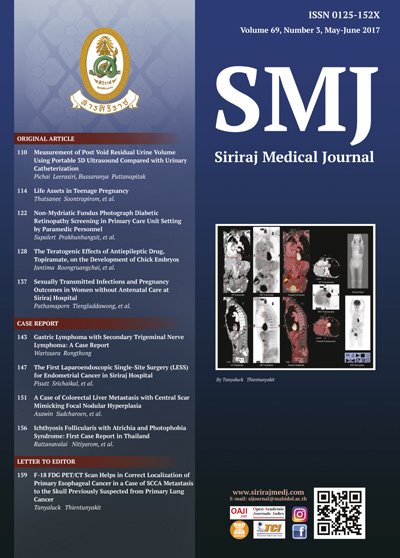Non- Mydriatic Fundus Photograph Diabetic Retinopathy Screening in Primary Care Unit Setting by Paramedic Personnel
Keywords:
Diabetic retinopathy screening, fundus camera, single-filed fundus photographs, paramedic personnelAbstract
Objective: To study the accuracy and agreement of non-mydriatic fundus photographic screening of diabetic retinopathy (DR) by well-trained paramedic personnel compared to retinal specialists and to obtain the prevalence of DR stages in primary care unit (PCU).
Methods: The non-mydriatic fundus photographs of diabetic patients taken at PCU were retrospectively reviewed and graded into three groups; no DR, non-proliferative DR (NPDR), proliferative DR (PDR) by two independent welltrained nurses compared to retinal specialists between November 2015 to March 2016. The results were statistically
analyzed to determine the level of agreement between the nurses and the retinal specialists. The sensitivity, specificity, positive predictive value (PPV), negative predictive value (NPV) and accuracy of each nurse were also calculated.
Results: Fundus photographs of 475 patients were obtained. The patients included 129 (27.2%) males and 346 (72.8%) females with the age of 59.94 ± 8.62 years. The agreements between two readers and the retinal specialists were moderate (κ =0.46 and 0.54). The sensitivity and specificity of the first reader were 71.69% and 87.91% and the second reader were 75.50% and 90.8%, respectively. The PPV and NPV were 42.69% and 98.11% for the first reader and 50.60% and 96.70% for the second. The overall accuracy of the first nurse was 86.1% while the second was 96.0%. The prevalence of any stages of DR was 11.1%, NPDR 10.5% and PDR 0.6%.
Conclusion: The single field non-mydriatic fundus photography read by trained paramedic personnel is one of the effective preliminary screening modalities. However, the continuous evaluation of the capabilities of the readers should be performed so that the patients with any stages of DR would be appropriately referred to ophthalmologists. This strategy would lead to the significant improvement of the DR screening in the country with high burden of diabetic patients.
Downloads
Published
How to Cite
Issue
Section
License
Authors who publish with this journal agree to the following conditions:
Copyright Transfer
In submitting a manuscript, the authors acknowledge that the work will become the copyrighted property of Siriraj Medical Journal upon publication.
License
Articles are licensed under a Creative Commons Attribution-NonCommercial-NoDerivatives 4.0 International License (CC BY-NC-ND 4.0). This license allows for the sharing of the work for non-commercial purposes with proper attribution to the authors and the journal. However, it does not permit modifications or the creation of derivative works.
Sharing and Access
Authors are encouraged to share their article on their personal or institutional websites and through other non-commercial platforms. Doing so can increase readership and citations.











